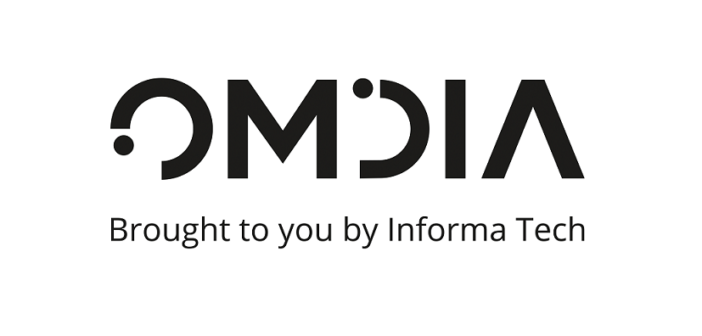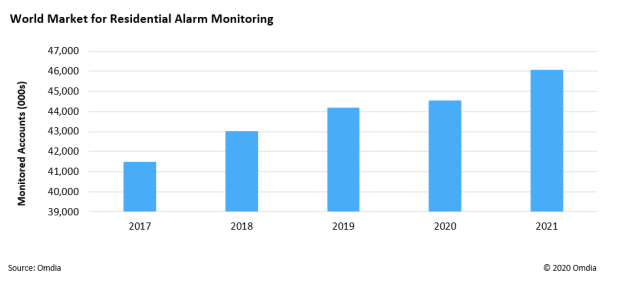
Global revenue forecast cut by 3 percentage points
The residential alarm monitoring market historically has been less susceptible to economic downturns than other industries, but amid the unprecedented economic carnage caused by COVID-19, even this sector is feeling the pain.
The global market for residential monitored security is expected to be flat this year, with the number of accounts set to rise by a scant 0.8 percent. Omdia’s previous forecast envisioned 3.8 percent growth for the year.
“In both good economic times and bad, consumers have been willing to open their wallets to spend on residential alarm monitoring—driving consistent growth in the number of accounts worldwide,” said Blake Kozak, principal analyst at Omdia. “However, the COVID-19 crisis is on a completely different scale than previous recessions. Not only has pandemic impacted consumer spending, but mass quarantines have inundated nearly every country across the globe. Consequently, the residential alarm monitoring industry Is destined to experience a sharp reduction in growth for the remainder of 2020.”
Regional markets feel the pain
The COVID-19 pandemic is heavily impacting regional residential alarm monitoring markets. In the Europe, Middle East and Africa (EMEA) region, account growth now is expected to total 2.5 percent in 2020—down more than half from the previous projection of 5.6 percent growth. The forecast reduction for Asia is even more dramatic, with the number of accounts in the region now expected to rise by only 1.5 percent this year, down by a factor of five from the previous expectation of 7.6 percent growth.
As of late May, there were signs that much of the United States was set to begin a phased approach to reopening the economy. This news is welcome to the alarm industry, especially companies that rely on door-to-door sales during the summer months. However, existing home sales have slowed and are expected to decline by as much as 25 percent in the United States in 2020, causing new installations of alarm accounts to be severely diminished.
Despite this, all is not lost during this quiet time for new accounts, since across the United States and in many other countries, installers can rely on the 3G sunset (in order to update cellular back radios from 3G to 4G) to continue entering homes and engaging with customers.
Partly because of this, Omdia does not expect major cancellations of existing contracts. Instead, the slowdown will be the result of less new business.
Growth opportunities amid the pandemic
Although the pandemic will impact account growth, the level of connectivity in homes is at an all-time high. This is presenting an opportunity for residential monitored security
providers to interact with customers and potentially upsell on connected devices, such as outdoor cameras. Such sales could help compensate for the slowdown in new contract growth.
Many alarm companies now are at or near their all-time highs for recurring monthly revenue (RMR). For example, Vivint now boasts monthly average revenue per user (ARPU) of nearly $65. Dealers should take this is a positive sign for professionally installed and monitored systems, especially since Ring, Nest and other do-it-yourself (DIY) systems continue to offer lower-cost monitoring.
Agile business models needed
DIY systems continue to take market share from traditional alarm providers. However, the rate of uptake of these DIY systems has not yet hit an inflection point with consumers. In fact, it’s plausible that a short-term increase in DIY systems will represent a net benefit for professional systems over the long term—especially as sellers of DIY systems frequently change their business models. As a result, the stability of these DIY brands can be unreliable, a phenomenon that may compel consumers to turn to professional systems vendors.
This will continue to be a challenging year for residential alarm dealers—largely because these companies must send representatives to enter consumers’ homes. This will require installers to don personal protective equipment (PPE), something that could spur concerns among consumers. With security solutions designed to promote a sense of stability and peace of mind among consumers, the appearance of PPE-clad workers in homes could be counterproductive.
This will continue to be a challenging year for dealers entering consumer homes since PPE will likely be required, during uncertain times, consumers seek out security systems that will provide peace of mind and stability. The entry of PPE-equipped workers into homes could clash with this image.
Dealers will need to adapt to selling home automation and security devices that can be useful in occupied homes, since the use of offices for working could see a sharp decline for the remainder of 2020 and into 2021. This means there will be less arming and disarming of the system—so using sensors for purposes other than security monitoring could provide installers and service providers a strategic advantage, as consumers use their alarm system in a less traditional manner for longer durations.







